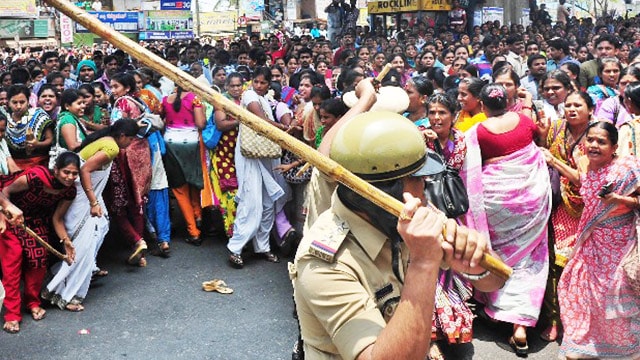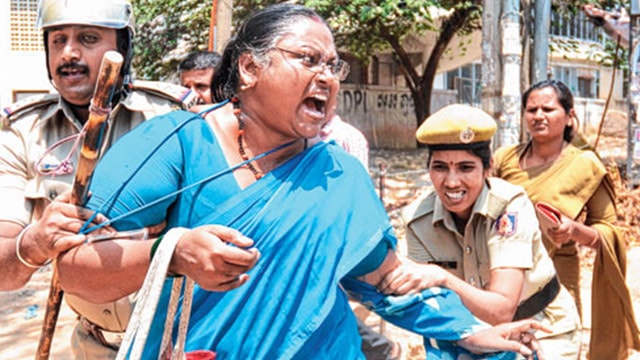A year after the painful protest by Bangalore’s garment workers against the decision of the Central Government to prevent them from withdrawing employers’ contribution from Provident Fund, a report by social activists has made several claims about police excesses on the workers, a majority of them being women workers. People’s Union for Civil Liberties – Bangalore (PUCL) and Women Against Sexual Violence and State Repression (WSS), brought out a 127 pages long joint report titled ‘Thread and Tension – An account of the historic uprising of garment workers’– which was reportedly compiled after interviews with workers, police officers and union leaders. The report (whose copy is also with Apparel Online) states that workers were quelled with police brutality and illegal detention of women. Given below are some highlights of the report which need serious attention.
The ‘wildcat strike’ of garment workers which occurred on April 18th and 19th in 2016 was of a kind that Bangalore had never seen before. More than 50,000 garment workers, a majority of them being women, gathered on the arterial roads of the city, and brought the traffic and normal functioning of the city to a grinding halt. Civil society activists claim that it was a strike that was waiting to happen. The report specially focuses on human rights violation by the police against garment workers in Bangalore. The report very sadly narrates, “Despite 90 per cent of the protesters being women, no women police officers were present. All the garment workers who were interviewed, repeatedly emphasized that seeing their female colleagues being violently beaten up by male policemen without justification, was in fact the turning point of the protest.”
This report truly raises concern as it describes about Chief Minister of Karnataka Siddaramaiah being seen congratulating the garment workers for creating “a successful workers’ movement”, which was “historic” and was able to push the Central Government to roll back the “ill-conceived amendments to the EPF Scheme”. While this protest has been lauded across the country as a victory for workers’ rights, especially for the distinctive role played by women workers, the state machinery has responded with repression and violence.
It may be recalled that workers and passers-by were assaulted brutally during the protest, and many were subsequently arrested on trumped-up charges, including attempt to murder. This was done to systematically create an atmosphere of abject fear, by targeting workers due to their vulnerable class character. The report further briefed about the plight of the workers who on the one hand were praised for their struggle by the State Government and its machinery, and on the other faced lathicharge by the police. The State Government needs to recognize that the garment factory workers resorted to such wide-scale demonstration as the Central Government’s move to restrict access to their EPF funds was the last straw on their already burdened backs.
“The level of brutality exhibited by the police both throughout the protest, and in the following weeks, was a concerted effort by the police to create an atmosphere of fear amongst the workers. This police action also began without following protocol as per the Karnataka Police Manual, which also involves giving prior warnings.”
The issue is not only limited to prevention of PF or police excesses, as the report further highlights the difficult conditions of women workers. The events of 18th and 19th of April 2016 have to be understood in light of the prevailing conditions of work in the garment industry, and not merely as a reaction to the EPF notification. One point which concerns the entire supply chain is the living wage. “The absence of a living wage standard also contributes to the acute dependence of workers on their PF, especially because the employee contribution to their provident fund is from an already low wage,” the report reasons in an unbiased way.
Social life too affected badly
While the garment industry employs a huge number of migrant workers, these workers have been heavily isolated and marginalized after the protests. Many workers spoke candidly about the stigma that they faced from their surroundings and community post-arrest and police action. One of the workers spoke about the criticisms and taunts that her children faced from others as an effect of these sudden arrests.
“A female worker was arrested at 2 pm on the first day of the protest, and was produced before the Magistrate at 9 pm on the following day. The Magistrate did not even acknowledge the fact that she wasn’t produced within 24 hours of her detention.
Even the management did not…
It (report) also blames the various managements who didn’t make any serious attempt to prevent workers from staging walkouts in their factories, and let the 2-day strike take its own course even while suffering significant losses in production. The managements seemed to condone these protests calculating that such actions would deflect the workers from turning to the fundamental worker issues of wages and working conditions and divert them from rising against the management.
Analysis of media (mainstream) reportage
The report also presents an analysis of mainstream media (English as well as local language newspapers) reportage. “This disingenuous statement clearly reflects the English media’s bias on the protest,” it says, and further adds that the media has also been silent on the role the EPF played in the workers’ lives, which pushed the workers to take to the streets, seeking justice. They barely alluded to the reason why EPF is important for these workers, or to the abysmal working conditions of these women in the garment factories, the humanly impossible production targets they face in their jobs, etc.
Demands
The fact-finding team has many demands for various authorities including the State Government, State Human Rights Commission, Department of Labour, Department of Health, etc. The foremost of these demands is that Chief Minister Siddaramaiah must follow up on his promise to release all those arrested in relation to the garment workers’ demonstration on the 18th and 19th of April 2016 and no new arrests must be made.
The horrible discrepancies of the Indian political and social system highlighted in this report have given enough reasons for worry to every stakeholder of the industry but the most dangerous thing is “…that we may expect similar resistances in future as these structures continue to oppress the workforce,” the report claimed.









